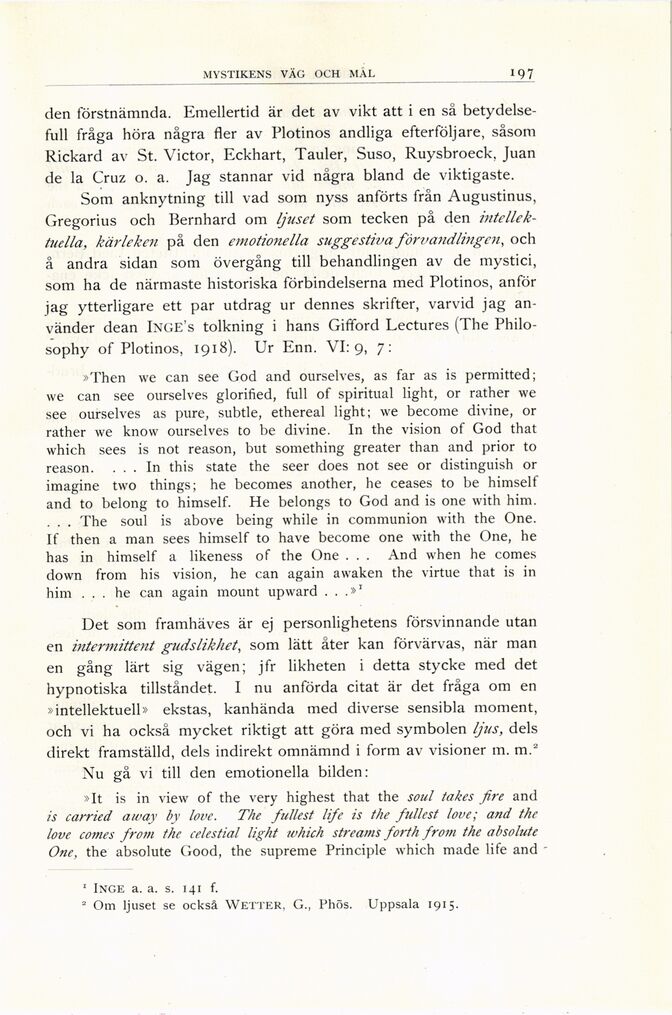
Full resolution (JPEG) - On this page / på denna sida - Sigurd Lindquist, Mystikens väg och mål - II. Det mystiska tillståndet och dess innehåll - C. Mystikens mål: unio mystica

<< prev. page << föreg. sida << >> nästa sida >> next page >>
Below is the raw OCR text
from the above scanned image.
Do you see an error? Proofread the page now!
Här nedan syns maskintolkade texten från faksimilbilden ovan.
Ser du något fel? Korrekturläs sidan nu!
This page has never been proofread. / Denna sida har aldrig korrekturlästs.
mystikens väg och mÅl
2 o 1
den förstnämnda. Emellertid är det av vikt att i en så
betydelsefull fråga höra några fler av Plotinos andliga efterföljare, såsom
Rickard av St. Victor, Eckhart, Tauler, Suso, Ruysbroeck, Juan
de la Cruz o. a. Jag stannar vid några bland de viktigaste.
Som anknytning till vad som nyss anförts från Augustinus,
Gregorius och Bernhard om ljuset som tecken på den
intellektuella, kärleken på den emotionella suggestiva förvandlingen, och
å andra sidan som övergång till behandlingen av de mystici,
som ha de närmaste historiska förbindelserna med Plotinos, anför
jag ytterligare ett par utdrag ur dennes skrifter, varvid jag
använder dean Inge’s tolkning i hans Giffard Lectures (The
Philo-sophy of Plotinos, 1918). Ur Enn. VI: 9, 7:
»Then we can see God and ourselves, as far as is permitted;
we can see ourselves glorified, full of spiritual light, or rather we
see ourselves as puré, subtle, ethereal light; we become divine, or
rather we know ourselves to be divine. In the vision of God that
which sees is not reason, but something greater than and prior to
reason. ... In this State the seer does not see or distinguish or
imagine two things; he becomes another, he ceases to be himself
and to belong to himself. He belongs to God and is one with hirn.
. . . The soul is above being while in communion with the One.
lf then a man sees himself to have become one with the One, he
has in himself a likeness of the One . . . And when he comes
down from his vision, he can again awaken the virtue that is in
him . . . he can again mount upward . . .»’
Det som framhäves är ej personlighetens försvinnande utan
en intermittent gudslikhet, som lätt åter kan förvärvas, när man
en gång lärt sig vägen; jfr likheten i detta stycke med det
hypnotiska tillståndet. I nu anförda citat är det fråga om en
»intellektuell» ekstas, kanhända med diverse sensibla moment,
och vi ha också mycket riktigt att göra med symbolen ljus, dels
direkt framställd, dels indirekt omnämnd i form av visioner m. m.2
Nu gå vi till den emotionella bilden:
»It is in view of the very highest that the soul takes fire and
is carried away by love. The fidlest life is the füllest love; and the
love comes from the celestial light which streams forth from the absolute
One, the absolute Good, the supreme Principle which made life and
1 Inge a. a. s. 141 f.
2 Om ljuset se också wetter, G., Phos. Uppsala 1915.
<< prev. page << föreg. sida << >> nästa sida >> next page >>